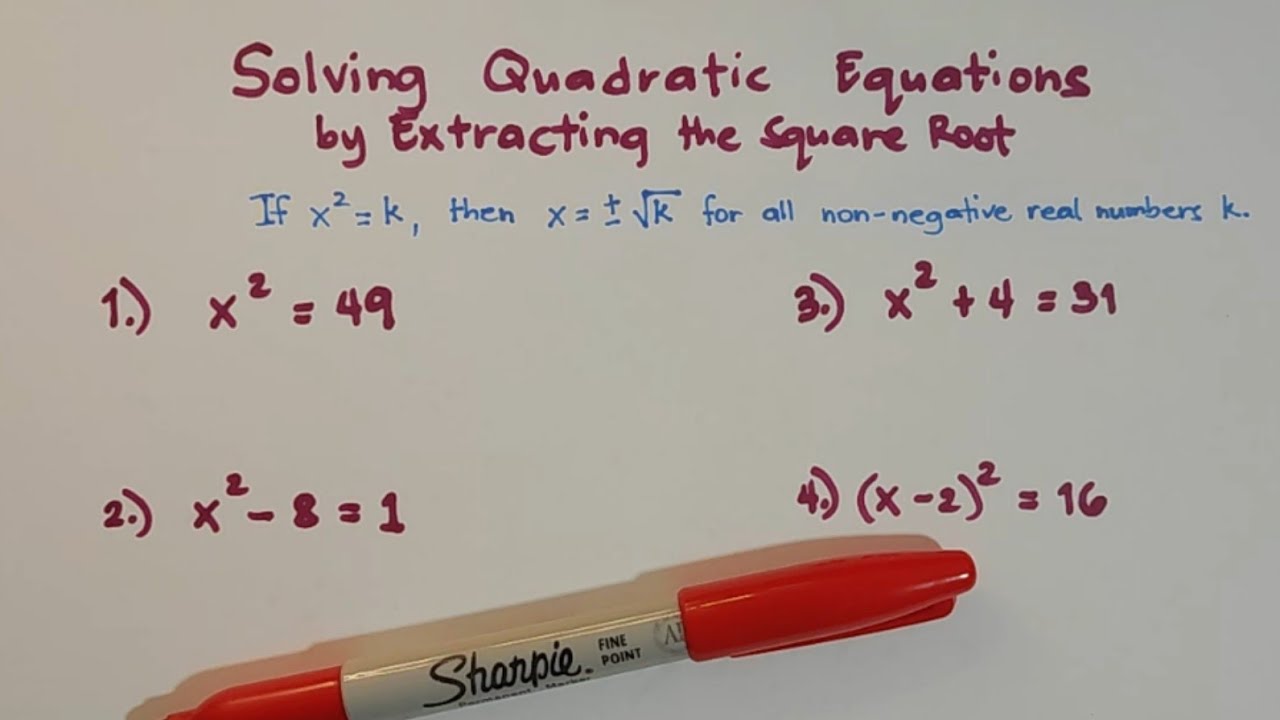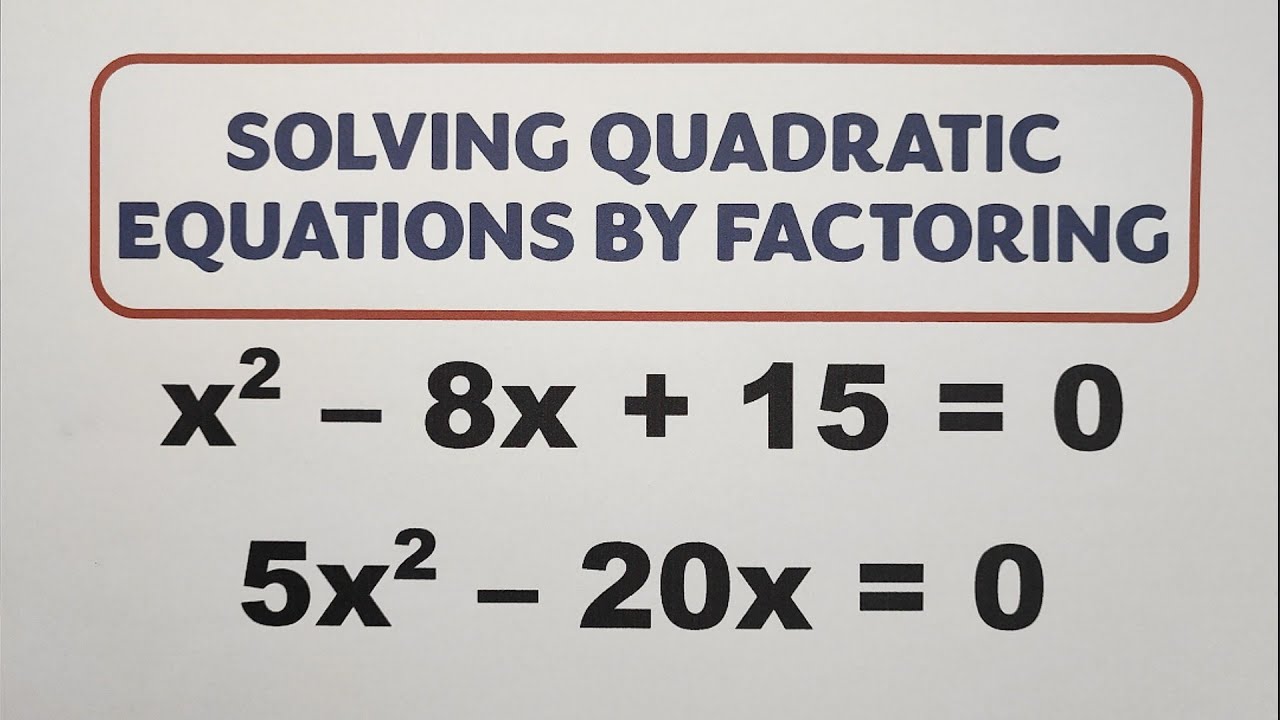Mudah Dipahami!!! Pemfaktoran Persamaan Kuadrat
Summary
TLDRThis educational video explains how to solve quadratic equations using the factoring method. The instructor provides clear examples, starting with simple quadratic equations and progressing to more complex cases. Key concepts include recognizing the general form of a quadratic equation, how to factor expressions, and determining the roots of equations. The video also covers special cases, such as when the equation has no real roots, explaining the discriminant and its role in identifying imaginary roots. Practical examples are used to demonstrate the steps, helping viewers better understand how to apply factoring to find the solutions.
Takeaways
- 😀 The quadratic equation has the general form: ax² + bx + c = 0.
- 😀 Factoring is a method used to find the roots (solutions) of a quadratic equation.
- 😀 When factoring, if the equation is in the form ax² + bx + c = 0, we identify two numbers that multiply to give the constant term and add (or subtract) to give the middle term coefficient.
- 😀 In a quadratic equation like x² + 3x - 10 = 0, the factors are (x - 2)(x + 5) leading to roots x = 2 and x = -5.
- 😀 If the equation has a leading coefficient (a ≠ 1), we factor by first dividing the coefficient and then applying the same factoring method.
- 😀 An example of this is 6x² + x - 2 = 0, which factors to (2x - 1)(3x + 2) with roots x = 1/2 and x = -2/3.
- 😀 When the equation does not have a constant term (c = 0), like x² + 5x = 0, we can factor by taking out the common factor (x), giving roots x = 0 and x = -5.
- 😀 Equations with only a² and c terms (e.g., 2x² - 8 = 0) can be factored using the difference of squares method.
- 😀 For example, x² - 4 = 0 can be factored as (x - 2)(x + 2) with roots x = 2 and x = -2.
- 😀 Some quadratic equations cannot be factored if the discriminant (b² - 4ac) is less than 0. These equations have imaginary roots.
- 😀 An example of an equation with no real roots is 2x² + 6 = 0, which has a discriminant of -48, and 3x² + x + 1 = 0, with a discriminant of -11.
Q & A
What is the general form of a quadratic equation?
-The general form of a quadratic equation is ax^2 + bx + c = 0, where a, b, and c are constants.
What is the method used to find the roots of a quadratic equation in the script?
-The method used in the script to find the roots of a quadratic equation is factoring.
In the example x^2 + 3x - 10 = 0, how do we factor the equation?
-To factor the equation x^2 + 3x - 10 = 0, we look for two numbers whose product is -10 and whose difference is 3. The factors are (x - 2) and (x + 5), giving roots x = 2 and x = -5.
What is the key difference when factoring quadratic equations with a negative product?
-When factoring quadratic equations with a negative product, we search for two numbers that have a difference equal to the middle term coefficient (b).
In the equation 6x^2 + x - 2 = 0, what steps are involved in factoring it?
-First, we write the factors as (6x) and (x), then find two numbers whose product is 12 and whose difference is 1. The correct factors are (3x - 2) and (2x + 1), giving the roots x = 1/2 and x = -2/3.
How do you factor an equation with only terms a and b, such as x^2 + 5x = 0?
-To factor x^2 + 5x = 0, we factor out x from both terms, giving x(x + 5) = 0. The roots are x = 0 and x = -5.
What happens when a quadratic equation has only terms a and c, and no b term?
-When a quadratic equation has only terms a and c, like 2x^2 - 8 = 0, we can factor it by first dividing the equation by 2 to simplify it to x^2 - 4 = 0, then apply the difference of squares formula to get (x - 2)(x + 2) = 0, with roots x = 2 and x = -2.
What is the difference of squares formula and how is it applied?
-The difference of squares formula states that a^2 - b^2 = (a - b)(a + b). It is used when factoring equations like x^2 - 4 = 0, where 4 is a perfect square, and can be factored as (x - 2)(x + 2) = 0.
What is a quadratic equation that cannot be factored?
-A quadratic equation cannot be factored if its discriminant is less than zero. This means that the equation has imaginary roots instead of real ones.
Can you provide an example of a quadratic equation that cannot be factored?
-An example of a quadratic equation that cannot be factored is 2x^2 + 6 = 0, where the discriminant is negative (-48), indicating that the roots are imaginary.
Outlines

This section is available to paid users only. Please upgrade to access this part.
Upgrade NowMindmap

This section is available to paid users only. Please upgrade to access this part.
Upgrade NowKeywords

This section is available to paid users only. Please upgrade to access this part.
Upgrade NowHighlights

This section is available to paid users only. Please upgrade to access this part.
Upgrade NowTranscripts

This section is available to paid users only. Please upgrade to access this part.
Upgrade NowBrowse More Related Video

Persamaan Kuadrat [Part 2] - Akar Persamaan Kuadrat Metode Memfaktorkan

Word Problems - Solving Quadratic Equations by Factoring

3 Cara mudah akar akar persamaan kuadrat

How to Solve Quadratic Equations by Extracting the Square Root? @MathTeacherGon

Solving Quadratic Equations by Factoring @MathTeacherGon - Grade 9 Math

2. Ecuaciones cuadráticas completas, solución por el Método de completar el binomio
5.0 / 5 (0 votes)